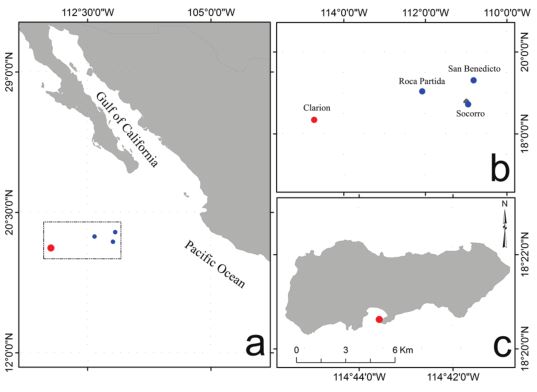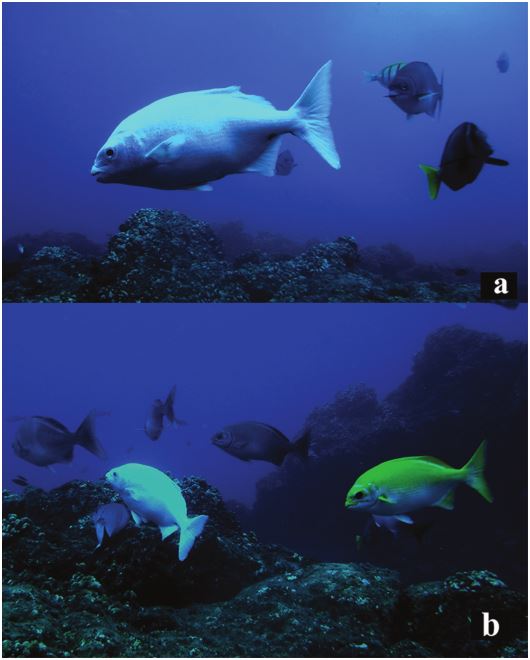The perciform genus Kyphosus Lacepéde, 1801 inhabits rocky and coral reefs from subtropical waters in both the Southern and Northern hemispheres (Knudsen & Clements, 2013; Sakai & Nakabo, 2014). The genus contains 11 valid species sensuKnudsen & Clements (2013, 2016), but the taxonomy of Kyphosus remains confusing and controversial to the point that several subgenera and subspecies have been erected and further synonymized (Gilbert, 2015; Knudsen & Clements, 2013; Sakai & Nakabo, 2014). Undoubtedly, the genus is still in need of a detailed review.
The Revillagigedo Archipelago harbors 4 species of Kyphosus: K. elegans, K. sectatrix, K. vaigiensis, and K. ocyurus (Knudsen & Clements, 2016; Robertson & Allen, 2015). Kyphosus lutescens was described as an endemic species from the Revillagigedo Archipelago by Jordan & Gilbert (1882) based on material collected from Socorro Island (holotype apparently lost); however, recent reviews using meristic characters and molecular markers by Knudsen & Clements (2013, 2016) suggest that the species is a junior synonym of K. sectatrix (Linnaeus, 1758), although Del Moral-Flores et al. (2016) mention that it should be considered as K. lutescens, without offering solid evidence. In particular, K. sectatrix has a circumtropical distribution inhabiting rocky and coral reefs from the eastern Pacific and across the Pacific Ocean to the Indian Ocean, including oceanic islands such as Revillagigedo and Hawaiian archipelagos, Easter Island, and south to northern New Zealand, the Red Sea and the eastern and western Atlantic and the Mediterranean (Knudsen & Clements, 2013, 2016; Roberson & Allen, 2015).
Morphometric (i.e., head width, pectoral fin length, isthmus width) and meristic characteristics (i.e., dorsal fin spines, dorsal fin rays, total number of gill rakers) are key to distinguish between species (Knudsen & Clements, 2016); but also, coloration and some color patterns. K. sectatrix is often grey to silvery with weak horizontal lines of slightly golden colored scales along the body. Often with a white or silvery streak on the cheek underneath the eye. Occasionally, the entire body is distinctively yellow, or with blotches or patches of black and yellow, known as ‘xanthism’ (Knudsen & Clements, 2013, 2016), or pale color (Randall, 2007). Xanthism in K. sectatrix is common at isolated oceanic islands in the Pacific Ocean such as Middleton Reef, the Kermadec Islands, Ogasawara Islands, Revillagigedo Islands, Easter Island, and the Hawaiian Islands (Knudsen & Clements, 2013, 2016), but less common in the Atlantic and Indian Ocean, the Azores and the Trindad Archipelago (Carvalho, 1950; Santos et al., 1997).
Anomalous body coloration in fishes usually occurs either as a deficiency of pigmentation known as “albinism” or as an excess called “hypomelanosis” or “melanism” (Jawad et al., 2013; Simon et al., 2009); whereas a particular form of albinism called xanthism is phenotypically expressed as a bright yellow or orange body coloration (e.g., Amaoka, 1995; Carson, 2011; Lewand et al., 2013). Albinism ocurrs in 2 forms: i) complete albinism, where the integumentary and retinal pigmentation is absent and ii) partial albinism or leucism, where there is a partial or complete loss of integumentary pigments, but the retinal pigments are present (Bottaro et al., 2008; Muto et al., 2013; Sandoval-Castillo et al., 2006; Reum et al., 2008). The present note reports the occurrence of partial albinism in an individual of the Revillagigedo sea chub K. sectatrix observed at Clarion Island, Revillagigedo Archipelago, Mexico.
Clarion Island is located inside a Natural Protected Area, the Revillagigedo National Park. On March 2016, while working with reef-related cryptic fish species in Clarion Island (Fig. 1; 18°20’37.51” N, 114°43’34.28” W), we observed 1 specimen of the Revillagigedo sea chub K. sectatrix exhibiting a rare example of abnormal body coloration. The specimen was seen and photographed on a rocky reef, at 10 m depth. We identified the specimen based on photographs and using illustrated guides by Humann & DeLoach (2004) and Robertson & Allen (2015). For valid names and systematics we followed Knudsen & Clements (2013, 2016).

Figure 1 a, Study area in the Mexican Pacific; b, Revillagigedo National Park; c, observation of K. sectatrix with partial albinism in Clarion Island, Revillagigedo Archipelago.
The body of the specimen observed was completely white, with small black blotches on the base of pelvic and caudal fins; eyes were black in color (Fig. 2a). The white Revillagigedo sea chub was observed inside a school of specimens with normal (grey-silvery) and xanthic coloration (yellow) (Fig. 2b). Abnormal color in this specimen coincides with description of teleost fishes with abnormal coloration (e.g., Kwun et al., 2016; Mansur, 2011; Muto et al., 2013, 2016) related to a dysfunctional melanin pigmentary system known as partial albinism. For the first time, we report this abnormal body coloration in K. sectatrix specimens in Mexican Pacific waters. This rare condition has been observed, but not reported, in other islands from Revillagigedo Archipelago such as Socorro Island, Roca Partida and San Benedicto (Ayala-Bocos pers. comm., 2016), hence the sea chub population with partial albinism in the archipelago includes several specimens. The specimen was photographed and not captured, and therefore, not measured, but it was similar in both size and shape to the rest of the school formation members of K. sectatrix as inferred from the images (Fig. 2b).

Figure 2 a, Partial albinism in Kyphosus sectatrix observed at Clarion Island; b, school of K. sectatrix with normal coloration, partial albinism and xanthic coloration.
Abnormal body coloration is related to several causes such as gene expression (Hernández & Sinovcic, 1987), diet deficiency (Kanazawa, 1993), variations in environmental conditions (Aritaki & Seikai, 2004), disorders in thyroid hormone (Okada, 2005) or dysfunctional melanin pigmentary system (Kinnear et al., 1985; Reum et al., 2008). This rare condition has been recorded in cartilaginous fishes from the Mexican Pacific such as Myliobatis californica (De Jesús-Roldán, 1990), Galeocerdo cuvier and Narcine entemedor (Sandoval-Castillo et al., 2006), Dasyatis longa (Escobar-Sánchez et al., 2009), Prionace glauca (Galván-Magaña et al., 2011), Carcharhinus obscurus (Bejarano-Álvarez & Galván-Magaña, 2013), and Carcharhinus limbatus (Sancho-Vázquez et al., 2015); but has also been reported for teleost fishes such as Haemulon sexfasciatus (Aguilar-Palomino et al., 1995) and Istiophorus platypterus (Vidaurri-Sotelo et al., 2005). Although Randall (2007) suggests that K. sectatrix can have a pale coloration, even white, this had never been recorded in Mexican Pacific waters.
Xanthic coloration in K. sectatrix is common at isolated oceanic islands such as Ogasawara, Japan (Masuda et al., 1984), the Revillagigedo Archipelago, Mexico (Gotshall, 1998), the Hawaiian Islands, United States (Randall, 2007) and Easter Island, Chile (Randall & Cea, 2010). In the Revillagedo Archipelago, we observed this condition in several species of teleost fishes such as Cephalopholis spp., Epinephelus spp., Arothron spp., Calotomus spp. and Nicholsina spp. In contrast, albinism is a rare condition and only has been recorded in 2 species along Mexican Pacific waters (H. sexfasciatus and I. platypterus).











 nueva página del texto (beta)
nueva página del texto (beta)


